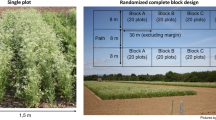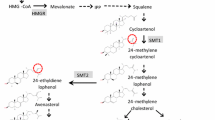Summary
Four populations of linseed derived from five parents were advanced from the F2 to the F6 generation by SSD and to the F5 by pedigree selection. These populations were used to compare the efficiency of the two methods in order to provide superior genotypes with respect to grain yield and oil content, i.e. oil yield. The results showed minimum differences between pedigree and SSD lines for grain yield, where in only one cross the SSD lines were significantly superior to the pedigree lines. Since pedigree selection was carried out for both, seed yield and oil content, a positive response to selection was expected. However, early selection for yield, a character with low heritability, was not successful. On the contrary, significant differences for oil content were detected between the two groups of lines in three of the four crosses studied. In these cases the pedigree lines were superior to the SSD lines. These results demonstrate that strict selection in early generations for oil content, a character with comparatively high heritability, is feasible and successful in linseed. However, selection for seed yield should be postponed to later inbred generations. Consequently, in breeding for maximum oil yield of linseed a two-step selection procedure is recommended.
Similar content being viewed by others
Abbreviations
- PS:
-
pedigree selection
- SSD:
-
single seed descent
- TGW:
-
thousand grain weight
References
Bickert, C., 1994. Untersuchungen zur Züchtung von Öllein (Linum usitatissimum L.) mit Hilfe der Antherenkulturtechnik und der Pedigree-Selektion im Hinblick auf eine Nutzung als nachwachsender Rohstoff. Diss. Univ. Giessen, 89 p.
Bickert, C., R. Bergmann, A. Büchsenschütz-Nothdurft & W. Friedt, 1994. Einsatz der Antheren- und Mikrosporenkultur in der Züchtung von Öllein im Hinblick auf eine Verbesserung von Fettgehalt und- qualität. In: Bericht 44. Arbeitstagg. 1993 AG Saatzuchtleiter. Gumpenstein, Österreich: 115–121.
Boerma, H.R. & R.L. Cooper, 1975. comparison of three selection procedures for yield in soybeans. Crop Sci. 15: 225–229.
Brim, C.A., 1966. A modified pedigree method of selection in soybeans. Crop Sci. 6: 220.
Cahaner, A. & J. Hillel, 1980. Estimating heritability and genetic correlations between traits from generations F2 and F3 of selffertilizing species: a comparison of three methods. Theor. Appl. Genet. 58: 33–38.
Casali, V.W.D. & E.C. Tigchelaar, 1975a. Breeding progress in tomato with pedigree selection and single seed descent. J. Amer. Soc. Hort. Sci. 100: 362–364.
Casali, V.W.D. & E.C. Tigchelaar, 1975b. Computer simulation studies comparing pedigree, bulk, and single seed descent in self pollinated populations. J. Amer. Soc. Hort. Sci. 100: 364–367.
Empig, L.T. & W.R. Fehr, 1971. Evaluation of method for generation advance in bulk hybrid soybean populations. Crop Sci. 11: 51–54.
Fehr. W., 1987. Breeding methods for cultivar development. In: J.R. Wilcox (Ed.) Soybeans: Improvement, Production and Uses. 2nd ed.: 249–293.
Fiuzat, Y. & R.E. Atkins, 1953. Genetic and environmental variability in segregating barley populations. Agron. J. 45: 414–420.
Fouilloux, G., 1988. Breeding flax methods. In: G. Marshall (Ed.) Flax: Breeding and Utilisation, Proceedings of the EEC Flax Workshops, Brussels, Belgium: 14–25. Kluwer Academic Publishers.
Friedt, W., 1992a. Möglichkeiten und Perspektiven der genetischen Manipulation von Flachs mit Hilfe von sexuellen und asexucllen Züchtungsmethoden. In: Le Lin — Recherche. Développement, Valorisation; Rouen, 20.–21.5. 1992, pp. 355–361.
Friedt, W., 1992b. Breeding and agronomic development of linseed and sunflower for technical markets. In: K. Anthony (Ed.) New Crops for Temperate Regions: 222–234. Chapman & Hall, London.
Friedt, W., C. Bickert & H. Schaub, 1995. Breeding of high linolenic. doubled haploid lines of linseed (Linum usitatissimum L.) using androgenesisin vitro. Plant Breeding (in press).
Goulden, C.H., 1939. Problems in plant selection. Proc. 7th Internat. Genetical Congress. Edinburgh, Scotland: 132–133.
Hoffmann, W., 1961. Lein,Linum usitatissimum L. In: Th. Roemer & W. Rudorf (Eds) Handbuch der Pflanzenzüchtung V, 2nd ed., 264–366. Paul Barey Berlin and Hamburg.
Jiaks, J.L. & H.S. Pooni, 1981. Comparative results of selection in the early and late stages of an inbreeding programme. Heredity 46: 1–7.
Jinks, J.L. & H.S. Pooni, 1984. Comparison of inbred lines produced by single seed descent and pedigree inbreeding. Heredity 53: 299–308.
Knott, D.R. & J. Kumar, 1975. Comparison of early generation yield testing and a single seed descent procedure in wheat breeding. Crop Sci. 15: 295–299.
Knott, D.R., 1972. Effects of selection for F2 plant yield on subsequent generations in wheat. Can. J. Plant Sci. 52: 721–726.
Köhler, W., G. Schachtel & P. Voleske, 1984. Biometrie. Springer-Verlag. Berlin, Heidelberg, New York, Tokio.
Luedders, V.D., L.A. Duclos & A.L. Matson, 1973. Bulk. pedigree, and early generation testing breeding methods compared in soybeans. Crop Sci. 13: 363–364.
Nichterlein, K. & W. Friedt, 1993. Plant regeneration from isolated microspores of linseed (Linum usitatissimum). Plant Cell Reports 12: 426–430.
Nichterlein, K., H. Umbach & W. Friedt, 1991. Genotypic and exogenous factors affecting shoot regeneration from anther callus of linseed (Linum usitatissimum L.). Euphytica 58: 157–164.
Ntare, B.R., M.E. Aken'ova, R.J. Redden & B.B. Singh, 1984. The effectiveness of early generation (F3) yield testing and the single seed descent procedures in two cowpea (Vigna unguiculata (L.) Walp.) crosses. Euphytica 33: 539–547.
Powell, W., P.D.S. Caligari & T.B. Thomas, 1986. Comparison of spring barley lines produced by single seed descent, pedigree inbreeding and doubled haploidy. Plant Breeding 97: 138–146.
Salas, G., 1993. Untersuchungen zur Optimierung der Züchtungsmethodik bei Öllein (Linum usitatissimum L.) unter besonderer Berücksichtigung verschiedener Heritabilitätsschätmethoden. Diss. Univ. Giessen, 114 p.
Tee, T.S. & C.O. Qualset, 1975. Bulk population in wheat breeding: Comparison of single-seed descent and random bulk methods. Euphytica 24: 395–405.
Author information
Authors and Affiliations
Rights and permissions
About this article
Cite this article
Salas, G., Friedt, W. Comparison of pedigree selection and single seed descent for oil yield in linseed (Linum usitatissimum L.). Euphytica 83, 25–32 (1995). https://doi.org/10.1007/BF01677857
Received:
Accepted:
Issue Date:
DOI: https://doi.org/10.1007/BF01677857




